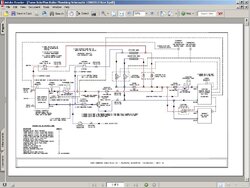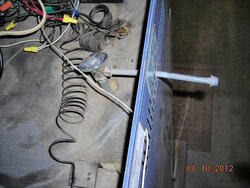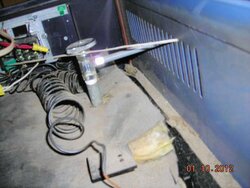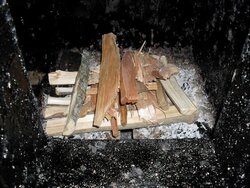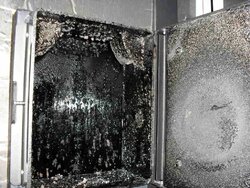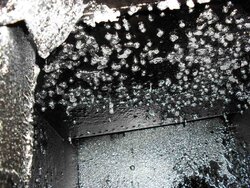Hello All,
My new Tarm Solo Plus 40 has now been in service for approximately one month and I have burned approximately 3/4 cord of kiln-dried firewood so far. My wood boiler is plumbed in parallel with my oil fired boiler that is interlocked to fire based upon an aquastat. I am finally getting the hang of proper load size for the given conditions which up to this point in Upstate NY has been relatively warm. With that said I have only been running the boiler when temps are around 40 DegF or lower. About the only issue I am experiencing at this point is that on the hottest part of a burn cycle I am getting a 'heart beat' sound in my boiler accompanied by a clanking sound in my supply header copper piping. My first inclination was that by burning the extremely dry kiln dried wood (10% moisture or less by my meter) that I was overfiring the unit with the Tarm supplied Condar thermometer reading 800 - 1000 DegF. After seeing a post in the forum questioning the accuracy of this thermometer I ordered a thermocouple meter and confirmed indeed that the thermometer was reading anywhere from 200 - 500 Deg F on the high side! In addition, I bought a draft gauge and at this point I can confirm that on repeated measurements my flue temps just after the boiler flue collar are between 350 - 500 DegF at the hottest part of the burn and the draft is between -0.04 and -0.05 InWc. These measurements are exactly in line with what Tarm recommends. After inquiring with multiple people including tech support at Tarm, my conclusion was that I had air in the system and that the thumping sound in the boiler and the pipes was being caused by the water flashing to steam then back to liquid. I tried bleeding the boiler at the purge valve in top but of course made a huge mess having to remove the insulation to wick the water up with rags. At that point, I decided to purge the entire system including the two boilers and all zone piping in the house. I first isolated the wood boiler completely (shutoffs at the supply and return headers) then opened the drain valve slowly and allowed approximately 75 gallons of water to be exchanged in the system using the auto fill valve at the regulator (mounted in supply line in supply header by recommened Tarm direct plumbing method). My thought being that if any air was trapped in the top of the boiler that by draining/filling the boiler in this way I would add water from the top pushing out any air in the sytem while exchanging the entire capacity of the boiler (55 Gallons plus approximatly 10 feet of 1 1/4 inch header piping). With the wood boiler remaining valved out I then did the same for the oil boiler. I then did each of the two heating zones one at a time valving everything out as I did each zone. I am pretty confident that I removed all air in the system. Then valved everything back in and fired up the oil boiler to temp and everything seemed great with no water fall sounds in the piping as I know from previously having air in the heating zone lines. I next fired up the wood boiler and it came right up to temperature (oil boiler of course interlocked shut down above 160 DegF per aquatstat) with the no thumping or heartbeat sounds (kettling). Measured flue temps and draft perfect. After operating continuously now for two successive days I loaded the boiler this morning with coals with a small load of wood to get me through a couple of hours before the big load when leaving for work. About ten minutes later the kettling had returned and the copper pipes were rattling again. I am stumped to say the least as I was confident I had this figured out. Are there any members out there running a Tarm Solo 30/40/60 without storage who have had this same issue and know what might be going on? Any help would be much appreciated. Also, am running a Grundfos 3-speed circulator at medium speed. Tried high speed thinking that maybe I was pulling enought heat out of the boiler but this did not help. Am now back to medium speed. Help!
Ken
My new Tarm Solo Plus 40 has now been in service for approximately one month and I have burned approximately 3/4 cord of kiln-dried firewood so far. My wood boiler is plumbed in parallel with my oil fired boiler that is interlocked to fire based upon an aquastat. I am finally getting the hang of proper load size for the given conditions which up to this point in Upstate NY has been relatively warm. With that said I have only been running the boiler when temps are around 40 DegF or lower. About the only issue I am experiencing at this point is that on the hottest part of a burn cycle I am getting a 'heart beat' sound in my boiler accompanied by a clanking sound in my supply header copper piping. My first inclination was that by burning the extremely dry kiln dried wood (10% moisture or less by my meter) that I was overfiring the unit with the Tarm supplied Condar thermometer reading 800 - 1000 DegF. After seeing a post in the forum questioning the accuracy of this thermometer I ordered a thermocouple meter and confirmed indeed that the thermometer was reading anywhere from 200 - 500 Deg F on the high side! In addition, I bought a draft gauge and at this point I can confirm that on repeated measurements my flue temps just after the boiler flue collar are between 350 - 500 DegF at the hottest part of the burn and the draft is between -0.04 and -0.05 InWc. These measurements are exactly in line with what Tarm recommends. After inquiring with multiple people including tech support at Tarm, my conclusion was that I had air in the system and that the thumping sound in the boiler and the pipes was being caused by the water flashing to steam then back to liquid. I tried bleeding the boiler at the purge valve in top but of course made a huge mess having to remove the insulation to wick the water up with rags. At that point, I decided to purge the entire system including the two boilers and all zone piping in the house. I first isolated the wood boiler completely (shutoffs at the supply and return headers) then opened the drain valve slowly and allowed approximately 75 gallons of water to be exchanged in the system using the auto fill valve at the regulator (mounted in supply line in supply header by recommened Tarm direct plumbing method). My thought being that if any air was trapped in the top of the boiler that by draining/filling the boiler in this way I would add water from the top pushing out any air in the sytem while exchanging the entire capacity of the boiler (55 Gallons plus approximatly 10 feet of 1 1/4 inch header piping). With the wood boiler remaining valved out I then did the same for the oil boiler. I then did each of the two heating zones one at a time valving everything out as I did each zone. I am pretty confident that I removed all air in the system. Then valved everything back in and fired up the oil boiler to temp and everything seemed great with no water fall sounds in the piping as I know from previously having air in the heating zone lines. I next fired up the wood boiler and it came right up to temperature (oil boiler of course interlocked shut down above 160 DegF per aquatstat) with the no thumping or heartbeat sounds (kettling). Measured flue temps and draft perfect. After operating continuously now for two successive days I loaded the boiler this morning with coals with a small load of wood to get me through a couple of hours before the big load when leaving for work. About ten minutes later the kettling had returned and the copper pipes were rattling again. I am stumped to say the least as I was confident I had this figured out. Are there any members out there running a Tarm Solo 30/40/60 without storage who have had this same issue and know what might be going on? Any help would be much appreciated. Also, am running a Grundfos 3-speed circulator at medium speed. Tried high speed thinking that maybe I was pulling enought heat out of the boiler but this did not help. Am now back to medium speed. Help!
Ken


